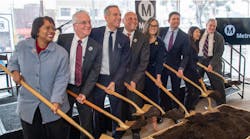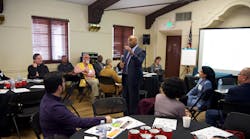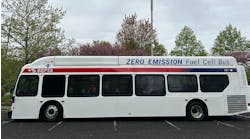The Los Angeles County Metropolitan Transportation Authority (L.A. Metro) has released its first assessment and equity report on Measure M, a sales tax supported by over 70 percent of voters in 2016 to invest in Los Angeles and a better transportation system. The 189-page report provides an overview of the first five years of Measure M funding (July 2017 – June 2022) and a fresh approach to assessing sales tax revenue through an equity framework that focuses on people first and the role Measure M and L.A. Metro play in quality-of-life outcomes.
Earlier this month, the Measure M Independent Taxpayer Oversight Committee (MMITOC) met and unanimously voted to accept the findings and recommendations of the five-year assessment and equity report of L.A. Metro’s Measure M sales tax program. The MMITOC is a panel of citizens whose mission is to ensure sales tax revenues are spent as intended. The assessment reviewed the projects and programs funded by Measure M, evaluated the program for its effectiveness and made a series of recommendations, as L.A. Metro continues to implement Measure M.
“The Measure M Independent Taxpayer Oversight Committee was formed as an independent committee to monitor and ensure that its tax revenues are spent effectively and efficiently,” said MMITOC Committee Chair Richard Stanger. “L.A. Metro has made impressive progress toward its goals over Measure M’s first five years, as can be seen in the Five-Year Assessment Report.
The Measure M Expenditure Plan was conceived as a road map to guide 40 years of transit investment in LA County. The measure’s original eight goals ranged from reducing traffic congestion, to expanding regional transit and improving neighborhood streets, allowing Los Angeles residents to get around more safely and easily. While L.A. Metro was able to shift gears in response to the COVID-19 pandemic and other impacts, the related disruption shifted the baseline for Measure M, as well as the future of Los Angeles. This five-year assessment has primarily shown L.A. Metro made difficult course adjustments while heightening its focus on equity and customer experience, however, the longer-term successes of the adaptations remain to be measured.
The report concluded L.A. Metro has advanced projects, programs and services that address many of the Measure M goals, particularly congestion management, transit expansion, local infrastructure repair and efforts around safety and affordability.
“I applaud L.A. Metro for its progress on these goals and for leading initiatives that are making public transportation more accessible, convenient and affordable,” said Mayor of Los Angeles and L.A. Metro Board Chair Karen Bass. “L.A. Metro’s ongoing programs help bring down the costs of travel for K-12 and community college students, riders who are income eligible and riders with disabilities. L.A. Metro is demonstrating its strong commitment to creating a world-class transportation system through these programs and its progress toward its goals.”
The assessment period of the report was notably marked by the COVID-19 pandemic, which upended the way people approach health, work and travel and, by extension, the patterns and values driving the transportation industry.
“When LA County voters approved Measure M in 2016, they declared their intention to remake our region into a more equitable, multimodal, accessible and economically prosperous place where the mobility benefits of transportation projects reached every corner of the county,” said L.A. Metro CEO Stephanie Wiggins. “Though the last five years have brought tremendous change, at L.A. Metro, our priorities related to Measure M remain the same: to deliver on our promises to LA County voters in an equitable, timely and cost-effective manner.”
About Measure M
Measure M outlined funding programs and major projects in the ordinance’s Expenditure Plan, mapping a 40-year forecast to advance the eight Measure M goals:
- Improve freeway traffic flow reduce bottlenecks and ease traffic congestion.
- Expand the rail and rapid transit system, accelerate rail construction and build new rail lines, enhance local, regional and express bus service and improve system connectivity.
- Repave local streets, repair potholes, synchronize signals, improve neighborhood streets and intersections and enhance bike and pedestrian connections.
- Keep the transit and highway system safe, earthquake-retrofit bridges, enhance freeway and transit system safety and keep the transportation system in good working condition.
- Embrace technology and innovation; incorporate modern technology, new advancements, and emerging innovations into the local transportation system.
- Create jobs, reduce pollution and generate local economic benefits, increase personal quality time and overall quality of life.
- Provide accountability and transparency, protect and monitor the public’s investments through independent audits and oversights.
As part of the Measure M Ordinance, five objectives were identified for assessment and approved by the L.A. Metro Board in early 2023:
- Assess L.A. Metro’s performance on the efficiency and effectiveness in delivering Measure M projects and programs
- Identify and evaluate any potential barriers in the delivery of the Expenditure Plan
- Identify and evaluate opportunities for process improvement
- Identify and evaluate best practices to be used going forward
- Identify and evaluate any organizational changes needed to improve coordination
Adopted in 2018, L.A. Metro’s Equity Platform guides equity implementation across the broad scope of the agency’s work and services provided. While a moral imperative, advancing equity also improves health and economic outcomes for marginalized communities by increasing access to education, economic opportunity, health and social services and other quality of life resources.
“Beyond the assessment criteria laid out in the Measure M ordinance, this report takes a deeper dive into issues related to equity and Angelenos’ quality of life,” Wiggins said. “In this way, we’re taking a fresh approach to looking at Measure M and its value to LA County taxpayers. We go beyond the dollars and cents to the way that Measure M affects people, their access to opportunity and their quality of life.”
Key takeaways from the assessment
- Efficiency and effectiveness in delivery: In its first five years, Measure M sustained L.A. Metro’s service and project delivery by strengthening Los Angeles’ “local match” competitiveness for other grants, helping to leverage more than $3 billion in state and federal funding in the five-year period.
- Potential barriers in the delivery: The COVID-19 pandemic disrupted every aspect of people’s lives. Transit agencies saw dwindling ridership, except for essential workers and those without other mobility options and had to adjust to altered travel behavior. L.A. Metro worked to adapt and pivot during this period, adopting new strategies for project delivery and strategically leveraging funding opportunities.
- Opportunities for process improvement: Led by its focus on equity and customer experience, L.A. Metro has further prioritized community engagement in project planning processes, which sometimes impacted early project schedules but focused on community input and ownership for stronger future project outcomes.
- Best practices to be used going forward: The tumultuous change that characterized much of the five-year assessment period has underscored the value of adaptability, partnerships and equity for Measure M implementation. L.A. Metro continues to work to incorporate equity into Measure M implementation, doubling down on reliable tactics, such as robust community engagement and equity data-driven service planning while initiating innovative ones, such as incorporating cultural competency strategies into project implementation for the East San Fernando Valley Light Rail Transit Corridor project.
- Organizational changes: While L.A. Metro has adapted in response to the many external and internal changes, the foundational element for future success remains in having people to do the work. Early in the assessment period, the agency underwent a hiring freeze, an incremental return to hiring only essential positions and incentivized retirement. Since then, L.A. Metro conducted a 2021 agencywide reorganization of major internal departments that consolidated departments to better coordinate. As part of L.A. Metro’s priority to restore service for riders, the agency initiated an aggressive bus operator hiring campaign and has worked to streamline hiring processes where possible. L.A. Metro notes rhe operator hiring push has shown early success, with transit service returning to pre-pandemic levels in late 2022 (shortly after the five-year assessment period). L.A. Metro has focused efforts to rebuild office workers and professional services staff. Future efforts to build back L.A. Metro’s workforce will have major impacts on Measure M implementation, including project budgets and schedules.
More information on Measure M can be found on L.A. Metro’s website.





